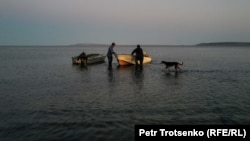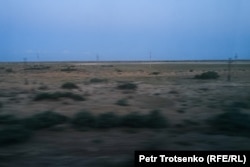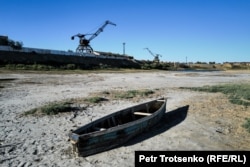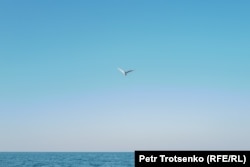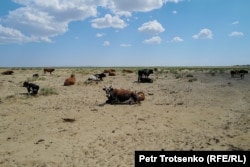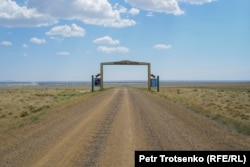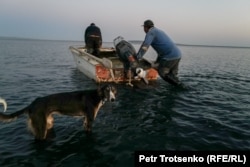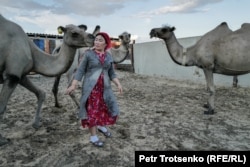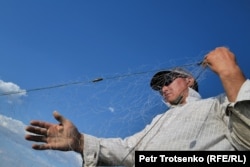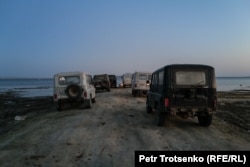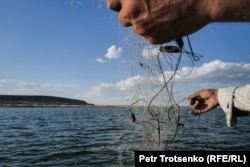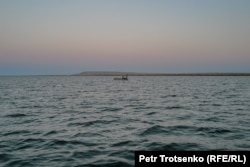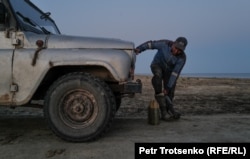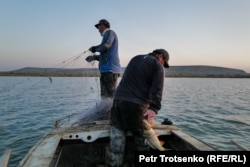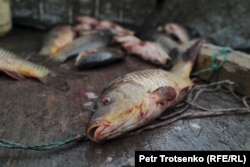Tastubek is a small fishing village located on the coast of the Aral Sea. When the waters of the sea receded due to Soviet-era irrigation projects, life here effectively stopped.
After the completion in 2005 of a dam that attempted to revive a corner of the barren sea, a small fishing industry was revived. Now the northern Aral sea is receding once more, but fishermen in the village of Tastubek still take out their boats each day to catch what they can.
In the predawn twilight, the steppes around the Aral Sea look bleak and endless.
The only features seen from the train I’m riding in are concrete power poles and the occasional herd of camels chewing the dusty grass.
My route runs from Kyzylorda to Aral, a city in southern Kazakhstan that once stood on the shore of a lake so huge that it was called a sea. The railway station here is still called "Aral Sea," although there hasn’t been a shoreline here for decades.
From Aral, it’s another 70 kilometers farther to reach the coast of the shrunken sea.
In the late 1980s, the shallowing Aral Sea split into two parts. The Syr Darya River flowed into the northern part, and a dam was planned that would seal up the inflow of the Syr Darya and prevent any of its waters draining towards the southern half of the Aral Sea
At first, the dam was made from sand and clay which was twice washed away. Eventually the World Bank allocated money for the construction of a concrete barrier, and in 2005 a 13-kilometer dam was completed. But it was far from a perfect fix.
The concrete dam is just 6 meters high, and the northern sea occasionally overflows into the south along with fish that die in the salty water on the other side of the barrier.
Now some are calling for the dam to be raised by another 6-8 meters to enable the northern sea to rise higher. But such an extension would require a massive investment.
In the mid-2000s, the project to save the northern Aral was considered a success. The reservoir filled up, salinity decreased, and fish stocks rebounded. The full revival of the Aral is still being discussed, but with less optimism than before due to the diminishing waters of the Syr Darya River.
In Aral, I step off the train and climb into a four-wheel-drive vehicle to cross the remaining desert to reach Tastubek, a village near the Aral Sea. Fishermen and cattle breeders live in the settlement; there are no other ways to make a living.
My driver, Serik, is a middle-aged Kazakh, born and raised in Aral. Serik heard from his parents about how the Aral Sea once lapped near Aralsk; he's too young to have seen it for himself.
Serik’s mother worked at a fish factory for 25 years. “It was a large factory, you could call it a city-forming enterprise,” Serik says. “When there was water in the sea about 3,000 people worked at the factory.”
His father worked at a shipyard, but when the water receded, Serik says, "all of these enterprises closed."
Serik runs a business out of Aral taking tourists to some of the famous places around the Aral Sea. He once took visitors to the famous “ship graveyard” but locals recently sawed up the ships and sold them for scrap metal.
Tourism is a good business, Serik says, but it’s strictly seasonal. In winter, no one comes here.
As we bump along a dusty gravel road, Serik talks about what has changed here in recent years. He says health problems that once plagued people in the region have apparently become less common. “The wind used to carry salt from the bottom of the dried-up sea and almost every second person had problems with their lungs and their kidneys,” the driver claims. “But now we don’t complain, it seems we’ve become less sick. We’ve probably gotten used to it. And the Northern Aral has risen, there’s less salt.”
Today around 120 people live in Tastubek. There is a school, electricity, and a slow Internet connection.
In the 1990s, the Aral Sea became so shallow that Tastubek all but died out. Just seven or eight families stayed on, only because they had nowhere else to go. After the dam was built and the water began to return to the northern part of the Aral Sea, people started to return. These were mainly unemployed youngsters who hoped to survive by fishing.
I meet two fishermen brothers in Tastubek -- Serzhan and Nurzhan. The younger brother, Nurzhan, is engaged in fishing and breeds camels and horses. His wife, Aykorke, works as a schoolteacher and raises their four children.
Nurzhan is a short, quiet man who talks about himself reluctantly.
“My father fished here, so did my grandfather, so I carry on the tradition. I like Tastubek, it’s calm and quiet, the sea is nearby, there’s fish,” he says.
"I could leave tomorrow if I felt like it, but I don’t want to. This is my home. In the summer we make fermented milk, in autumn we sell meat, and in the winter and spring we fish."
Nurzhan has a large new house, which is still being completed. In the yard, there is a pen for camels and several sheds. In the evenings, Aykorke milks the camels and begins the fermentation process for the fizzy milk that is a popular drink in Kazakhstan throughout summer. At the entrance to the house, hunting dogs sit waiting. In autumn they will be busy when Nurzhan starts shooting ducks along the coast and hares on the steppe.
Fishing is also partly seasonal. In winter and spring, fish in the Aral Sea are more active and easier to catch in nets. Through the cooler months, a fisherman’s haul also stays fresh longer for transport to city markets. In summer, the fish of the Aral Sea tend to swim deeper where the water is cooler and they can be hard to catch. Most of the fishermen working the Aral Sea in summer are catching fish only for themselves and their families.
The fish population is directly linked to the depth of the Aral Sea, locals say. When the water level sinks, so does the fish population. In 2019, water levels on the Syr Darya River were low and fish became scarce.
“There were years [a long time ago] when we caught 80–100 kilograms a day, now that's only a memory,” Nurzhan says.
On the shore when we visit in the evening, several Soviet-designed UAZ vehicles are already parked up and fishermen are busy preparing boats in the shallows. After 20 minutes to get their boat set up, Nurzhan and Serzhan are on their way in their small vessel.
The boat picks up speed and heads toward the sunset. The shore disappears from view and the greenish water foams under the propeller. Nurzhan sits at the stern, controlling the motor with one hand and holding a GPS navigator with the other. The device helps him find the exact place where he needs to set the nets.
The place where we stop is shallow enough that you can see the bottom. Serzhan says the sea has been getting shallower in recent years, although he says, "there's a little more water this year, and there are more fish, too."
Back on the shore, after their nets have been cast, the brothers talk about the kinds of fish they can catch in the Aral. Carp, pike perch, and asp are caught here, among others. Nurzhan says that, in the late 1980s, flounder fry from the Sea of Azov were released into the Aral as it was drying. The fish unexpectedly thrived, apparently due to the saltiness of the sea -- ideal conditions for flounder. Once the dam was built and the water levels rose, the salinity decreased and the flounder eventually disappeared.
By the time we return to Tastubek, it's getting dark. At the fishermen's house, we eat boiled camel meat and settle in for a short sleep. In summer, it gets light early and you need to go back out to check your nets before sunrise.
The alarm goes off at 3:30 a.m. The village is totally silent. Even the dogs and birds are sleeping now; only bats can be seen fluttering through the night air in search of prey.
No one is really awake, so we just bump toward the sea in silence in the brothers’ old UAZ.
Even after boarding the boats and setting off, it is still dim when we reach the first float – a plastic bottle, indicating where the brothers’ net is. The first net brings in 18 medium-sized carp.
The second net brings in ten carp and two bream.
"This is normal for summertime," Serzhan says of the catch, though he sounds disappointed. A little further away, another boat is bobbing on the waves. It looks as if this competitors' catch is not very rich either.
Seagulls circle overhead, hoping to snatch fish, but they don't risk coming close; there are too many people in the boat. The brothers return the nets to the water and head back to shore.
Another day stretches ahead for the brothers filled with the usual concerns of rural life: horses, camels and fixing the UAZ, which is having engine problems again.
This is the third installment of a series of photo stories from the Syr Darya River and its tributaries. The waterway passes from the mountains of Kyrgyzstan through Tajikistan, Uzbekistan, and finally into the Aral Sea in Kazakhstan. Photo correspondent Petr Trotsenko from RFE/RL's Kazakh Service followed the length of the river to document how it sustains life in Central Asia and spoke to experts about the current state of this vital waterway. The first and second installments can be viewed here and here.




